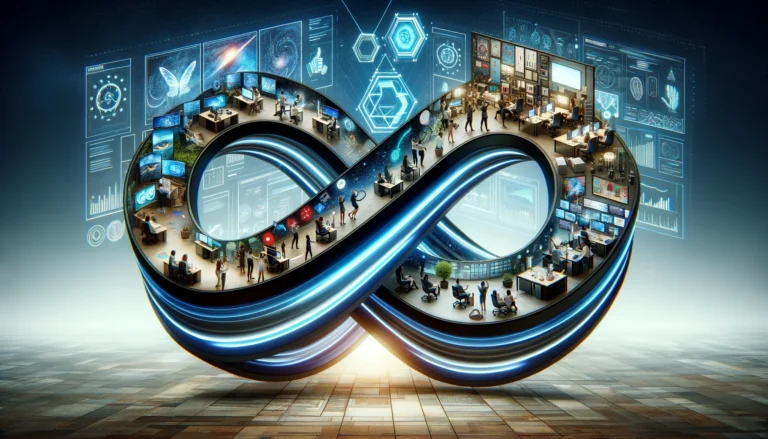The journey into SaaS doesn’t always start with a quest for tech dominance. For those looking to build a solid, scalable SaaS business without groundbreaking tech, beginning with service offers a safer route. This strategy leverages existing demands, ensuring a firm foundation for additional features.
It works both for launching a company as well as launching new additions and functionalities on top of an existing platform.
Act 1: In the Beginning, There Was Service
Picture this: You’re offering a service, solving problems like a modern-day MacGyver, armed with nothing but your wits, expertise, experience and maybe a Swiss Army knife. This is where you test the waters, dive into the deep end, and see if there’s enough interest to build a business. Granted, it will be more of a consulting or ‘project’ business at the start. But it’s a business, it pays the bills, and oh boy, it is enlightening to interact with customers and hear what they really want. Consider it a grassroots market research phase where customers are paying you to do the market research. Referring to the ‘golden circle’: you are defining the ‘what’ you deliver, while staying flexible on ‘how’ you deliver.
Let’s go back a few years for a practical example. An expense management company wants to automate the data collection from the receipts, as end users hate having to type the data in the tool. At that time, doing automated text recognition was still a big challenge, especially across multiple languages. Worse, the company’s founders had a huge understanding of accounting and tax issues but could hardly be considered tech wizards. Sidestepping the technology hurdles, they launched a service for ‘automatic data collection’, working with a specialized subcontractor that had a ‘human’ team standing by 24/7 to read the receipts and enter the data within 4 hours after scanning. Customers just loved it, even if the price per ‘scanned’ receipt was quite high.
Act 2: The Method to the Madness
Now, you’ve got traction. People love what you’re doing, the word-of-mouth magic is generating a lot of leads, but you’re one person, not an octopus. Time to bring in the cavalry and hire some additional people. To make sure these new hires provide the same service and customer value as you did, you start developing a methodology that you can pass on like a sacred scroll. New joiners just must follow the cookbook, and while it won’t be as easy for a new hire as starting at McD flipping burgers according to the task sheets, it will really help you get new people up to speed quickly. This is your playbook for scaling your business without losing that personal touch that got you here in the first place.
Switching back to our expense management company. More and more customers are using the ‘automatic’ data collection option, and that means the volume of receipts increases dramatically. To streamline the hiring of new people and to ensure consistent treatment of the receipts, the expense management company and the subcontractor define guidelines on how to enter the data and an onboarding process for new employees.
Now there you are with a proven value proposition, a documented methodology and a growing demand … and a fundamental conundrum. Even with your cookbook, you can’t scale as fast as your customers would like without blowing up your costs. Time to start looking for new solutions to decrease the ‘manual’ work.
Act 3: The Wizards Behind the Curtain
Here’s where the magic happens. You start weaving automation into the fabric of your service. It begins with tiny spells—scripts here, a software patch there—until, before you know it, you’ve got a full-blown software platform. This isn’t about replacing the human touch; it’s about amplifying it, making your service smarter, faster, and available 24/7, just like a diner but with better coffee. Admittedly, it’s a bit of a fixer-upper and you’re grateful your customers can’t look under the hood, but hey, it works, and customers love it.
Our expense management company does the same. Rather than just sending the images of the receipts to the subcontractor, they build a basic software tool to already extract the raw data from the image using some standard Google Vision functionality. Over time, some simple ‘matching’ algorithms are added to put the right data in the right fields allowing the tool to fill in the critical fields such as ‘amount’, ‘currency’ and ‘date’. The job of the subco shifts from raw data extraction to validating and correcting the result of the rudimentary automated process.
Act 4: The Industrial Revolution
The end of your odyssey is nigh. You have a working SaaS solution, your customers are happy, your company is growing … and your solution is still a bit shaky and costs too much. And in SaaS, unit economics are key. Time for an industrial revolution! Or ‘refactoring’ in SW terminology. The hard work has already been done. You have paying customers who are happy with the service you provide. Now you just focus on optimizing how you deliver that service. From scratch you create a new robust platform to replace the organically grown hodgepodge of scripts you have built over the last months.
And how does that final step look like for our expense management company? With all the human-verified data collected by the rudimentary scanning solution, the company now has a treasure trove of data to start training a neural network to do the actual ‘data collection’ from the images of the receipts. Two measures of human-verified data, add one Google Vision, mix with some Tensorflow for machine learning, shake (but do not stir), and voila … a fully automated state-of-the art automated data collection solution to automate the data collection from receipts in more than 20 languages.
Curtain Call: Your Turn to SaaSify
So, there you have it, a journey from hands-on service to hands-off software, with a few pit stops for coffee and code along the way. The road from service to SaaS is paved with insights, automation, and a dash of daring. Whether you’re starting with a fully manual process or somewhere in the middle, the destination remains the same—a SaaS platform that stands the test of time and tech. Ready to start your SaaSification Odyssey? Remember, every great journey begins with a single step, or in this case, a service.



